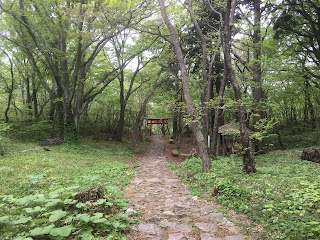Golden week wasn't much of a week this year. Friday 29 (Showa/ Hirohito day) was a holiday. Tues 3 (Constitution Day)- was a also a holiday - though a bit of a thorny issue at the moment since the government has made laws to circumvent Article 9 of the Constitution - that Japan not fight wars of aggression or the wars of other countries. One university I teach at had classes, presumably motivated by wanting to appear as they were dissuading students from partipating in protests aimed at preserving the Constitution, decided to have classes for the day, despite the public holiday. Wednesday, 4th was Greenery Day (celebrating Japan's love of concrete perhaps?) and today is Children's Day (which used to be Boy's day - though girl's day still remains but not as a public holiday).
I popped up to Akita briefly - night bus both ways because although it takes 9 hours, it's more efficient with time. On Monday we went on a day trip to Oga Peninsula via Gojo(no)me** and the former lake known as Hachirogata which was turned into rice fields as vile engineering experiment that destroyed the lake and lake culture to produce rice in a country where rice was already in surplus by the time the reclamation project had finished.
I've put pictures in of the reclamation museum (which Hiro's father did the interior for)
here.
**[I think it goes under two pronunciations, Wikipedia and the local news call it Gojome, but Hiro's mother calls it Gojonome, so I am guessing Gojonome is a dialect form and Gojome is the standard Japanese name.]
First port of call was the Gojo(no)me Michi no Eki. Michi no Eki are a bit like farmers markets with other odds and sods for tourists on sale. In terms of produce the mountain veges were expensive (by local standards) and things like lotus root chips on sale out the front all came from overseas or other parts of Japan... But, the backyard of the Michi no Eki was seriously impressive. The back door opened up into a forest and Hiro's parents were gleefully pointing out the various mountain flowers and vegetables. To my eyes the poisonous ones don't look particularly different from the delicacies... I'll stick to buying vegetables at the vegetable shops...
 |
| Behind the Gojo(no)me Michi no Eki |
 |
| Damako characters at the Gojo(no)me Morning market |
 |
The morning market
The real story here wasn't the produce, though the produce wouldn't be found in a Tokyo vegetable shop. The real story was that everyone selling vegetables was at least more than 70 and more likely more than 80 in most cases. There were no young people to be seen... I guess going to the mountains to pick veges to sell isn't what young people do... a shift at 7-11 would be much easier and more reliable money. Going to places like this makes me realize I need to improve my Japanese. The dialects would be a bit difficult to wade through, but Japan has changed a lot since these people were young. |
 |
| Fish and flowers at the morning market |
 |
| Canola on Hachirogata |
 |
| The lake that was Hachirogata that became Ogata Mura |
 |
| Canoloa on Hachirogata |






















